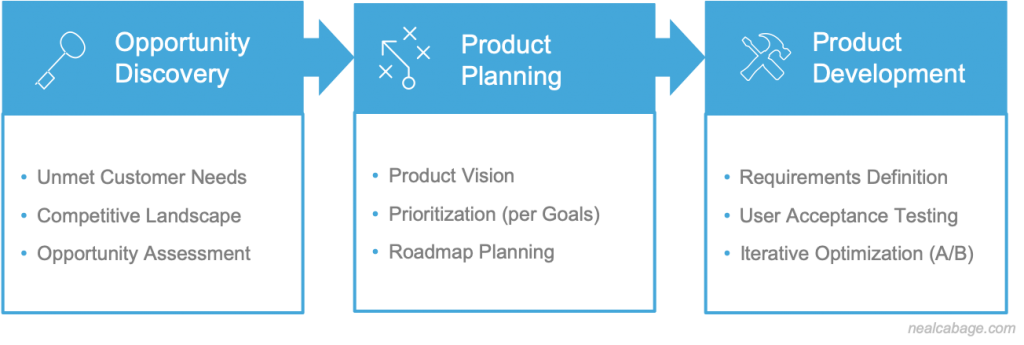3 Pillars of Product Management

The role of Product Management is often misunderstood by those outside of Product, and even some within Product who haven’t received appropriate training. It is for example tempting to think of the role as being responsible for delivering on internal initiatives for internal stakeholders but that is Program Management. Another common misperception is that Product Managers write requirements for how the system should work, including the integration of two internal systems … but isn’t that a Business Systems Analyst (BSA)? So what exactly is Product Management then?
What is Product Management?
Fundamentally, Product Management is about solving the needs of users, and doing so in a way that can be produced at scale, so customers can receive disproportionate value compared to the cost. It Is therefore the Product Managements responsibility to deeply understand the needs of users, the opportunities in the market where value can be created, and oversee the creation and refinement of this product overtime, so that maximum value is being created for customers as well as the business, if the endeavor is successful.
This is an important definition to understand because it positions the Product Manager fundamentally addresses a few key mis-understandings about Product:
- Product Managers fundamentally serve the customer, not the business
- The focus is upon understanding the market and customer needs, not internal systems
- Maximum business value is realized by focusing on creating value for customers
- Product-Market fit is the top priority, not speed of delivery
- This is a role much bigger than just the Scrum Product Owner
- This definition is well-aligned to the original role of Product Management as it was first imagined in at Proctor & Gamble in the 1930’s
The 3 Pillars of Product
With that as a backdrop, the 3 Pillars of Product Management from Neal Cabage does a nice job of concisely describing the role as having 3 main areas of focus:
i. Opportunity Discovery – Arguably this is the most important aspect of Product Management because this is how we understand what to build and why, thereby maximizing our chances of success. If you don’t do this part well, then all the panning and development in the world cold be for not. Common activities at this stage are user research to understand what users want and need, competitive landscape analysis to understand competitor strengths, weaknesses, and evaluation of opportunities ultimately, to determine where to focus efforts.
ii. Product Planning – Once an opportunity has been aligned on, the next step is to figure out what a product might look like that addresses the opportunity, and the key initiatives that would be needed to realize that vision. Those initiatives are prioritized, aligned to resourcing, and ultimately expressed on a roadmap, that will guide product development.
iii. Product Development – Product Development is finally the part where requirements (user stories) are written, the backlog is groomed, UAT testing and post-launch optimization activities occur. This is the part most people think of when they hear the term Product Management, but in fact, that is only the Scrum Product Owner part of the role. It is an important part of the role, but it is equally important to remember that is just one piece of the puzzle, and actually the two proceeding steps are equally if not more important, for the ultimate success of the product.
Conclusion
It is tempting to think of Product management from purely a functional perspective, in which Product merely writes requirements, prioritizes the backlog, and, ensures efficient delivery of things on the roadmap. This is not a healthy definition of the role however, because the fundamental value proposition of Product Management, is to ensure we’re building the right product, not simply delivering it. To focus entirely on delivery ignores the primary responsibility of Product Management. And this is why a simple, concise framework such as the 3 Pillars of Product Management is so important, to help easily frame the role so energy and communication are focused accordingly.


